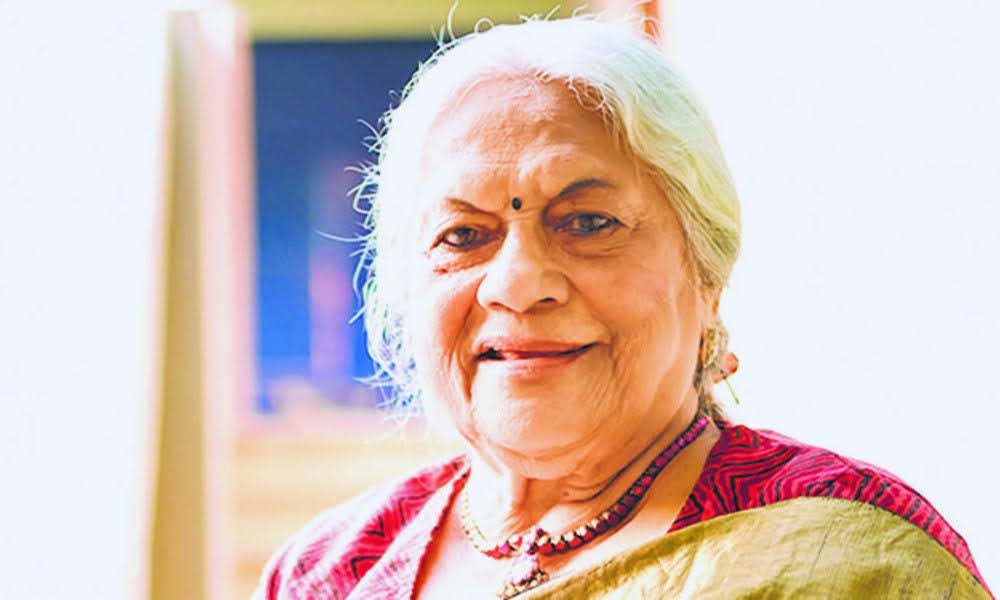Kumudini Lakhia: The Quiet Revolutionary Who Reimagined Kathak and Empowered Women

Kumudini Lakhia, a towering figure in Indian classical dance and an influential Kathak exponent, passed away on Saturday morning at the age of 95 at her residence in Ahmedabad.
Known for her quiet strength, steely resolve, and artistic innovation, she left an indelible mark on the world of dance.
A prayer meeting is scheduled for April 15 at Sindhu Bhavan, Bodakdev, Ahmedabad. The funeral took place Saturday afternoon.
A Quiet Revolutionary in the World of Kathak
With a gentle, cheerful presence, Kumudini Lakhia may not have appeared to be a revolutionary. Yet, for over six decades, she challenged patriarchal structures within the Kathak tradition.
At a time when questioning dance masters was unthinkable, she encouraged young women to pursue dance on their own terms.
By developing a unique choreographic language, she broke away from Kathak’s restrictive and often regressive narratives.
Her work infused contemporary relevance into traditional forms, drawing global attention. Above all, she redefined the role of women in Kathak — from passive performers to thinking artists.
Humble Beginnings and Lifelong Dedication
Kumudini Lakhia was awarded the Padma Vibhushan this Republic Day for her lifelong commitment to Kathak. Earlier, she had received the Padma Shri in 1987 and the Padma Bhushan in 2010, among other accolades.
Her teaching journey began in a modest space inside her husband’s automobile shop before she founded Kadamb Centre for Dance in 1965.
Referred to fondly as “Kumiben” by her students, she cherished her role as a teacher more than that of a performer.
Senior disciple Rupanshi Kashyap shared, “Kadamb has been a home away from home. A hands-on guru, Kumiben was always available for us… She was delighted when we came up with our inputs to her productions.”
In an earlier interview, Lakhia had remarked, “I hate slavish obedience. My students should never hesitate to question — that is the only way to make learning and teaching exciting.”
A Legacy of Nurturing Artists
Bengaluru-based dancer couple Nirupama and Rajendra recounted in a Facebook post, “When we told her that her art, her legacy continues here in the south… she held our hands tight and kissed. Her eyes were moist… She said — ‘I don’t just teach dance, I create dancers.’”
Her legacy includes mentoring renowned Kathak artists such as Aditi Mangaldas, Vaishali Trivedi, Sandhya Desai, Daksha Sheth, Maulik Shah, Ishira Parikh, Prashant Shah, Urja Thakore, and Parul Shah, among many others.
From Ram Gopal to Global Acclaim
Lakhia was born in 1929 and began her career dancing with Ram Gopal, who introduced her to the global stage.
Despite her foundational training in traditional Kathak, she joined Gopal in London, where she discovered a wider interpretation of dance.
She once said, “When touring with him I realised choreography is not just about well-conceptualised movements, it’s also about well-coordinated lighting, costume, makeup and music.”
Her constant pursuit of new material shaped her as a choreographer. Though she found success as a soloist, it was her transition to group choreography that made her a true innovator.
Her performances featured abstract themes, minimalist costumes, and ballet-inspired movements, while retaining classical Indian musicality.
Choreographic Innovations and Film Contributions
In 1967, Lakhia established the Kadamb Centre for Dance in Ahmedabad and, by 1973, began focusing on choreography. Her group compositions broke away from the solo-centric structure of traditional Kathak.
Some of her most celebrated works include Dhabkar (Pulse), Yugal (The Duet), and Atah Kim (Where Now?), which she performed at the Kathak Mahotsav in Delhi in 1980.
She also contributed choreography to Muzaffar Ali’s classic film Umrao Jaan (1981) alongside Gopi Krishna.
Tributes Pour In
Prime Minister Narendra Modi expressed his condolences, stating, “Deeply saddened by the passing of Kumudini Lakhia ji, who made a mark as an outstanding cultural icon… A true pioneer, she also nurtured generations of dancers.”
Gujarat Chief Minister Bhupendra Patel added, “She trained many disciples in classical dance and exposed the glory of Kathak… May God grant peace to her soul.”
The Spirit Behind the Dance
Reflecting on her artistic journey, Kumudini Lakhia once said, “I did what I did not because I wanted to be called an experimentalist or an innovator… So I see myself in Kathak and my dance is what I am.”
Her vision, courage, and creativity not only modernised Kathak but also empowered generations of dancers to find their own voice.
Through her teaching and choreography, Kumudini Lakhia ensured that Kathak remained a living, evolving art form.









